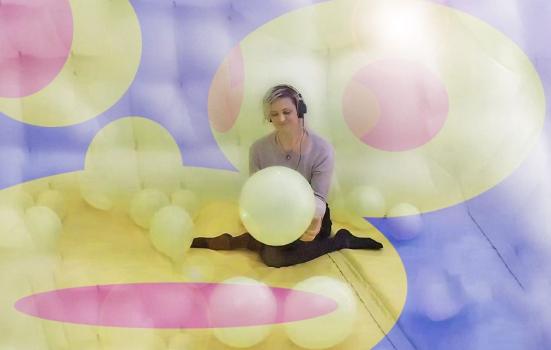The cultural sector is wary of AI. But Jo Burnham thinks a change of mindset can accelerate learning, confidence and innovation with emerging tools.

Harriet Waters [digitally modified]
Many in the arts don’t really want to think about AI. Perhaps the term invites visions of dystopia and feelings of technological overwhelm at a time we crave stability and familiarity.
Or maybe people have grown weary of being excitedly informed that the Metaverse is just around the corner, while in their own underfunded organisations, simply enjoying a stable Zoom call is an achievement.
Given that context, this instinct towards apathy or avoidance is understandable. But it might be a big mistake.
Recognising the scale
AI isn’t the next Google Analytics, Facebook or smartphone. In terms of its coming influence, it’s closer to the next Internet, next computer or even the next printing press - revolutionary.
AI has been around for decades - we already use it daily - but for useful, adaptable and multi-purpose generative AI, we’re right at the start. Already, it has a startling number of professional applications, with more being discovered all the time.
You can log on to Claude right now and start a conversation about a piece of copy or ask it to identify flaws in your audience strategy, or to re-write this article in the voice of the Cookie Monster. Immediately, for free, with no seminar or overly enthusiastic workshop required, you have a hugely impressive (though flawed) digital ‘brain’ at your service.
However, we can be forgiven for some nervousness about AI. During a speech at the Royal Society last month, Prime Minister Rishi Sunak outlined scenarios including terrorists causing mass destruction with the technology, the development of biological weapons, and even losing control completely: “Mitigating the risk of extinction from AI should be a global priority”, he said.
So far, so terrifying. But fear leads to avoidance. It may seem as if we’re taking steps to inform ourselves of potential dangers when we read a new hand-wringing article, but that’s a misstep.
A better way forward
We need to engage with AI first-hand to see what it’s good at - and what it’s not; to recognise patterns that can be extrapolated across generative AI. For example, what it thinks beauty is, how it represents different communities, what it censors and what it deems ‘inappropriate content’.
When you experience AI ‘hallucinating’ information on a subject you’re familiar with, you can check for this in future. Find out if AI can show kindness if you divulge a secret, or offer insights in the analysis of a convoluted spreadsheet. Test it with impossible questions such as: “Why do businesses think Microsoft Teams is a good piece of software?”
Playfulness is our superpower
I encourage our sector to embrace playfulness. Playfulness isn’t optimism or a naive rejection of criticism. Playfulness is a deliberate, strategic practice of exploring a concept, a tool or a toy, on your own terms, following your own curiosity and making connections between ideas.
It allows you to safely explore concepts that otherwise might be too emotionally charged, to better immunise yourself against rampant hype, to develop richer critical awareness and use tools in ways they were never designed. Perhaps to discover unexpected applications that the creators never imagined. You also learn much faster when you’re having fun.
This approach isn’t confined to AI. As a child, I didn’t go to school. I was a raised in the unschooling philosophy where formal curriculums are redundant. Instead, children are encouraged to learn about and play whatever they find interesting. That experience has become a foundational template for how I approach any new challenge.
You might find you design your first computer game with GPT4, create a gingerbread replica of your favourite historical building with DALL·E 3, or learn a new strategy for having a difficult conversation from Pi.
A real opportunity
But embracing playfulness is not just for individual benefits, although this is valuable. I urge our sector to embrace playfulness as a collective opportunity not just to keep up with the larger commercial sector’s use of AI, but to surpass it in innovation, quality, fairness and representation.
Playfulness is our superpower. We often work in small, agile teams that value creativity and collaboration. Frustrating as it is, we’re familiar with working on a shoestring and finding creative solutions to problems that larger businesses simply throw money at.
We also talk and support each other, sharing discoveries and innovations. For all the lavish offices and top talent Netflix might afford, its competitor might discover an efficiency which remains confidential and, as such, does not benefit the industry as a collective.
By acting as thousands of decentralised R&D departments, embracing playfulness with different AI tools, combinations and applications, we can develop and share innovations to our working practices and strategies faster than larger organisations working in silos. The quality of our data alone is an untapped wealth waiting to be extracted - years of customer surveys, digital metadata and booking patterns can generate real-time insights to help us fight for our organisations and better engage audiences in meaningful ways.
I want to see the arts develop a reputation as a natural home for AI best-practice and innovation, to better shape the application of this technology, fight against censorship, influence policy, and take a prominent seat at the table representing artists and creatives making the inevitable decisions around copyright and digital plagiarism.
Get started
For now, put that out of your mind. Instead, subscribe to the Civic AI Observatory newsletter, learn about MidJourney, create a song with Suno, discover a YouTuber or mix two AI tools together that have never interacted before.
Give yourself permission to be silly, naughty, light-hearted and curious. Get messy, make mistakes, and share what you find most interesting. It might just lead to something extraordinary.
Jo Burnham is Marketing Campaigns Manager for Brighton Dome & Brighton Festival and a freelance speaker and trainer on AI.
 linkedin.com/in/jo-burnham/
linkedin.com/in/jo-burnham/
![]() jo.m.burnham@gmail.com
jo.m.burnham@gmail.com
![]() @Jo_m_Burnham
@Jo_m_Burnham




